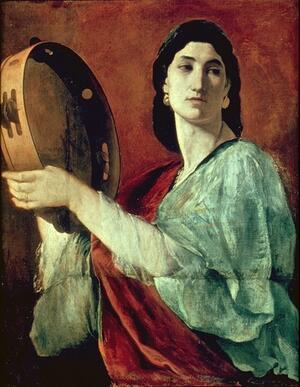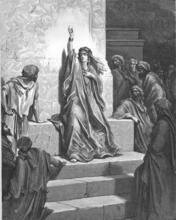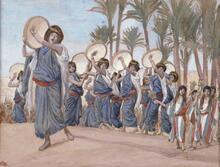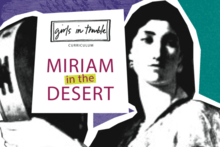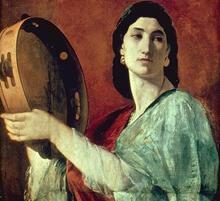Miriam: Bible
Miriam is best known for helping to deliver Moses at the Nile River and leading the Hebrew women in singing, dancing, and playing drums after crossing the Red Sea. Later, she and her brother Aaron challenge the actions and authority of Moses. She understands leadership to embrace diverse voices, female and male. But the price of speaking out is severe; God punishes her, after which she never speaks, nor is she spoken to. Centuries later, prophecy remembers her as the equal of Moses and Aaron in representing God before the people, and as the inaugurator of a performance and composition tradition of song, drums, and dances in Israel.
Miriam the Prophet
Exodus 2:1–10 features an unnamed sister of Moses who helps deliver him at the Nile River. Many commentators identify her as Miriam. Two genealogies listing Moses, Aaron, and Miriam as the sole children of Amram support the identification (Num 26:59; 1 Chr 6:3). She first appears by name, however, in the crossing of the Red Sea (Exod 15:20–21). Called “the prophet Miriam, Aaron’s sister,” she leads Hebrew women in singing, dancing, and playing drums.
Though the meaning of the term prophet is here indeterminate, Miriam is the first woman ever to bear it. She becomes thereby the archetype of the female prophetic tradition, even as Moses heads the male (compare Deut 34:10). Contrary to the impression that her one stanza sung at the sea (Exod 15:1–18) is but an abridgement of the lengthy song attributed to Moses (Exod 5:1–31), historical and literary studies show that the latter version is itself the Song of Miriam. It belongs to a corpus of women’s traditions that include the long Songs of Deborah (Judg 5:1–31) and Hannah (1 Sam 2:1–10).
Clashing with Moses
After the episode at the sea, Miriam surfaces in the wilderness narratives. Accompanied by her brother Aaron, she speaks out against Moses (Num 12:1–6), faulting him for marrying a Cushite woman. But the text fails to explain the issue. The woman is not named. She may be Zipporah, the known wife of Moses (Exod 2:21, 18:2), or another woman. The meaning of “Cushite” is uncertain. It may refer to the African country of Cush (see Gen 10:6; 1 Chr 1:8) or to Midian, the region east of the Gulf of Aqabah from which Zipporah came (see Exod 3:1, 18:1; Hab 3:7). Most probably, the attack implicates Miriam in a struggle over the priestly leadership of Moses.
Miriam with Aaron also challenges the prophetic authority of Moses. She asks, “Has the Lord spoken only through Moses? Has he not spoken through us also?” (Num 12:2). She understands leadership to embrace diverse voices, female and male. But the price of speaking out is severe. Though God rebukes both Miriam and Aaron, the deity punishes only her. Metaphorically, the divine nostril burns in anger to leave her stricken with scales like snow. Aaron pleads with Moses on her behalf, and Moses appeals to God. God responds by confining her outside the camp for seven days. This period of time verifies her cleanliness but does not restore her to wholeness. Whatever her particular disease, Miriam remains a condemned woman, a warning for generations to come (see Deut 24:8–9). After her punishment, she never speaks, nor is she spoken to. Indeed, she disappears altogether from the narrative until the announcement of her death and burial at Kadesh (Num 20:1).
Influence
Negative as well as positive traditions about Miriam testify to her prominence, power, and prestige in early Israel. She participates with Moses and Aaron to lead the Israelite community during the exodus and the wanderings. Her role in saving her baby brother and in celebrating the crossing of the sea highlights her concern for her people. Later they reciprocate. Despite the instructions of God and Moses, the people refuse to continue the march in the wilderness until the diseased Miriam is restored (Num 12:15). Three references to them at her death further underscore their loyalty to her.
Nature also honors Miriam. At her triumphal entry, the living waters of the Red Sea surround her (Exod 15:19–20); at her demise the wells in the desert dry up (Num 20:2). Centuries later, prophecy remembers her as the equal of Moses and Aaron in representing God before the people (Mic 6:8). Moreover, prophecy includes her, though not by name, within its eschatological vision. Jeremiah says that in days to come, Israel will have a new exodus. It will go forth again with drums, dances, and merrymakers (Jer 31:4). As the inaugurator of a performance and composition tradition of song, drums, and dances in Israel, Miriam continues to resonate throughout its musical life (see Pss 68:25; 81:2; 150:4).
Unlike most women in the Bible, Miriam is never called wife or mother. She has neither husband nor children. Jewish traditions, however, cannot tolerate her status as single. The historian Josephus deems Hur the husband of Miriam (Antiquities 3.54; see Exod 17:10–12). Rabbinic sources give her Caleb for a husband and Hur for a son (but compare 1 Chr 2:19).
In the New Testament Miriam’s afterlife continues through her name and her deeds. The Greek name Mary is the equivalent of the Hebrew Miriam. In singing a song of deliverance (Luke 1:46–55), in embodying a demonic or diseased condition (Luke 8:2), and in challenging male authorities (Matt 28:10; Luke 24:10; John 20:11–18), the various Marys of the Gospels reflect their namesake.
Brenner, Athalya. The Israelite Woman: Social Role and Literary Type in Biblical Narrative. Sheffield, England: 1985.
Meyers, Carol, General Editor. Women in Scripture. New York: 2000.

